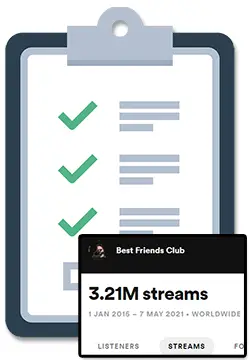If you want to know how to grow a YouTube channel about music, particularly if you’re a musician that’s trying to get into like vlogging or if want to be a successful musician on YouTube, I’ve researched the topic, experimented myself and wrote down my findings here for you.
To start & grow a music channel on YouTube, you need to consistently post videos that viewers are searching for (1 or 2 times per week) and focus on giving value to your audience through entertainment, education, or a combination of both.
Although things like titles, thumbnails, and video quality can be important, they won’t truly help you build your YouTube channel unless you are consistently posting valuable content worth watching.
Taking a look at my channel above, you may notice that I have a pretty small amount of subscribers and viewers, which is why I’m personally going to be taking the advice I’ve researched here to grow my own YouTube channel and I think you will get a crazy amount of information from my successes and failures.
If you want to learn more about growing a music Youtube channel, how you can get paid for using YouTube, and how to build a successful and official artist channel, simply keep on reading, my friend. 🙂
How To Grow On YouTube As An Artist
To grow on YouTube as an artist you need to post consistently (1 or 2 times per week) and focus on giving value to your audience through entertainment, education, or a combination of both.
By consistently providing value, your audience will grow over time which will allow you to monetize your channel on and off of YouTube through advertising, partnerships, and product sales.
In addition to value and consistency, it is important to make sure that the videos you make are based on topics that people are searching for, that your thumbnails and titles are optimized to get the highest amount of clicks, and that your video content is optimized for keeping the viewer watching for as long as possible.
The YouTube algorithm rewards videos with high click-through rates (percentage of people that click your video when they stumble upon it) and high watch times (how long viewers watch your video) by recommending that video to other users on the platform.
Lastly, in terms of video quality, the most important thing to focus on is the audio quality as most viewers will click off videos if they are hard to understand. Picture or image quality, by comparison, is much easier to tolerate when it is not as professional.
Grow Your Music Channel By Giving Value
What’s important to remember if you want to grow a music channel on YouTube as Musician Vlogger or artist is that you can’t just post boring things like what you’re doing every day in your life or traditional “vlog” style videos unless you have a well-established fanbase that is interested in that.
If you’re just starting out and your audience is small, it is really important to really give some kind of value in the form of education, information, or entertainment in each video in addition.
Focus on giving value and weave in your personality and your journey – the progression of how things are moving along as you try to reach your goals – to build a relationship with your audience.
The video can be based around what you are having for breakfast each day but make sure to be informative, educational, or entertaining so that your viewers will actually get something meaningful out of each video.
Shift your focus from yourself to the viewer if you want to succeed.
Get More Views On YouTube For Music By Being Consistent
The 2 main reasons it is important to be consistent with how much you post on YouTube is because the more videos you post, the more chances you have for your videos to get picked up by YouTube’s recommendation algorithms and because fans want to make sure you are serious if they are going to join you on your journey.
Think about how you use YouTube yourself: after finding an interesting video, you will usually see what other videos they have and decide if you want to subscribe to see more, right?
What happens when you personally discover a YouTuber but notice that they haven’t posted anything in months and months?
It sends a signal that they have abandoned YouTube and will not be posting fresh and updated content – so what exactly is the point of subscribing to them if you won’t be getting new videos?
Again… shift your focus from yourself to the viewer if you want to succeed.
How To Be A Successful YouTube Musician
To be a successful YouTube musician, you need to find your niche by posting consistently (1 or 2 times per week), and serve your audience by focusing on giving value to your audience through entertainment, education, or a combination of both.
Through consistency you will:
- Have more chances to get picked up by the YouTube recommendation algorithms
- Give fans a reason to subscribe to see more from you
- Find your niche AKA what your audience likes and does not like (so you can double down on what works)
It takes a lot of time and effort (for most it takes 1 to 2 years to see some traction), but the payoff is massive: having an audience that actually cares about what you are up to.
Having an engaged audience is key to the next step which is actually making some money from YouTube.
How Do Musicians Makes Money On YouTube?
The 3 main ways that musicians can make money on YouTube are by getting their channel monetized, doing partnerships or sponsorships with companies, and by recommending products or services off of YouTube to their audience.
There are other ways that musicians can make money from YouTube (such as music publishing royalties) but these are the most common.
Musicians can get their YouTube channel monetized by reaching 1,000 total subscribers in addition to 4,000 watch hours in the last 12 months. Once monetized, YouTube will place ads on eligible videos that the musician will get a cut from.
Once an artist’s channel has grown a decent amount, they may get reached out to by companies to have some of their videos ‘sponsored’. Usually, in exchange for a flat fee, the artist will dedicate a segment (or 2) in their video to mention a product or service.
Musicians can make money from affiliate sales (a cut from the sale of someone else’s product or service) or by selling their own digital or physical products (ie: merch, courses, downloads) by mentioning them in their video and including links in the video’s description.
How Much Musicians Make On YouTube
Musicians can make roughly $0.00069 per view or around $6USD per 1000 impressions if their channel is monetized. Although musicians can make much more through sponsorships and affiliate or direct sales, the majority of musicians on YouTube do not make any money.
DistroKid “YouTube Money” Explained
If you are using DistroKid as your music distributor, they have an extra (and optional) feature called “YouTube Money” where they can help you collect any money owed from YouTubers that have used your music in their videos.
When you opt into using “YouTube Money”, DistroKid will add your song to YouTube’s Content ID database so that it can identify when your music shows up in any video hosted on YouTube.
From there, YouTube will be actively looking to find your song in every video on YouTube. If they do find your song in a video, YouTube will automatically turn on ads for that video.
For more on this, check out my article called: Does DistroKid Upload To YouTube? 🙂
How I Am Starting A YouTube Channel About Music
At the time of making this article, if you look at my current amount of subscribers or any of the videos that I have right now, it’s pretty clear that I haven’t really grown my own YouTube channel to any staggering heights.
However, I’ve conquered the Spotify algorithm (3.5 million streams and 7+ Spotify editorial playlists) and now have a pretty good idea of how I can now conquer the YouTube algorithm.
The way that I’m going to be doing this is by adding in vlog-style videos each week in addition to the more information-focused videos that solve a specific problem that I’ve already been posting regularly.
These vlog-style videos are going to be a little bit more laid back but still give valuable information on what I’m doing each week to actively pursuing a career in music – the results, my success, and failures.
In this way, viewers can learn things from my experiences (and personal money spent) so that it’s a little bit easier for them when they’re trying to build a career in music themselves.
A big part of what I do to really grow my project is dropping new songs every single month with detailed music promotion. So, I’ll also be providing monthly updates on new releases and breaking down the very specific results of each campaign:
- What I’ve learned
- What worked for me
- What didn’t work for me
- If I’m spending any money how much i’m spending
- If I’m making any money how much i’m making
When you’re first starting out it can be daunting because there’s so much that you need to worry about.
I want to show you what I’m doing so you can see what works or not.
This way you will have a better idea of what to do yourself and learn from my mistakes and failed experiments.
How To Get An YouTube Official Artist Channel Using DistroKid
DistroKid has the ability to upload your music to YouTube Music, which is YouTube’s streaming service. By uploading your music to YouTube Music using DistroKid, you unlock the ability to upgrade a YouTube channel you may own into an “Official Artist Channel”, which is cool.
By selecting “YouTube Music” when submitting a song for distribution using DistroKid, your song will also be sent to regular old YouTube on your Official Artist Channel (if you’ve upgraded your YouTube channel) or to what is called a “Topic Channel” if you have not.
If you haven’t upgraded your artist’s YouTube channel to an Official Artist Channel, then YouTube will post your music on what is called a Topic Channel.
The difference between Official Artist & Topic Channels on YouTube
An Official Artist Channel is a type of YouTube channel created by Google that allows you to bring all your content from any different YouTube channels you may have into one place.
This type of channel automatically places your music catalog into an area called “Music Videos” on your channel’s page:

It also adds a cute little music note beside your channel’s name:

A Topic Channel, on the other hand, is an automatically assigned channel that is assigned to artists that do not have their own official YouTube channel.
Topic Channels have the word “- Topic” after the artist’s name:

Also, artists with smaller play counts may have their music automatically added to a generic “Various Artists – Topic” channel until they become more popular and YouTube automatically creates their own Topic Channel or if they claim their own Official Artist Channel.
For more on this, check out my article called: Does DistroKid Upload To YouTube? 🙂



